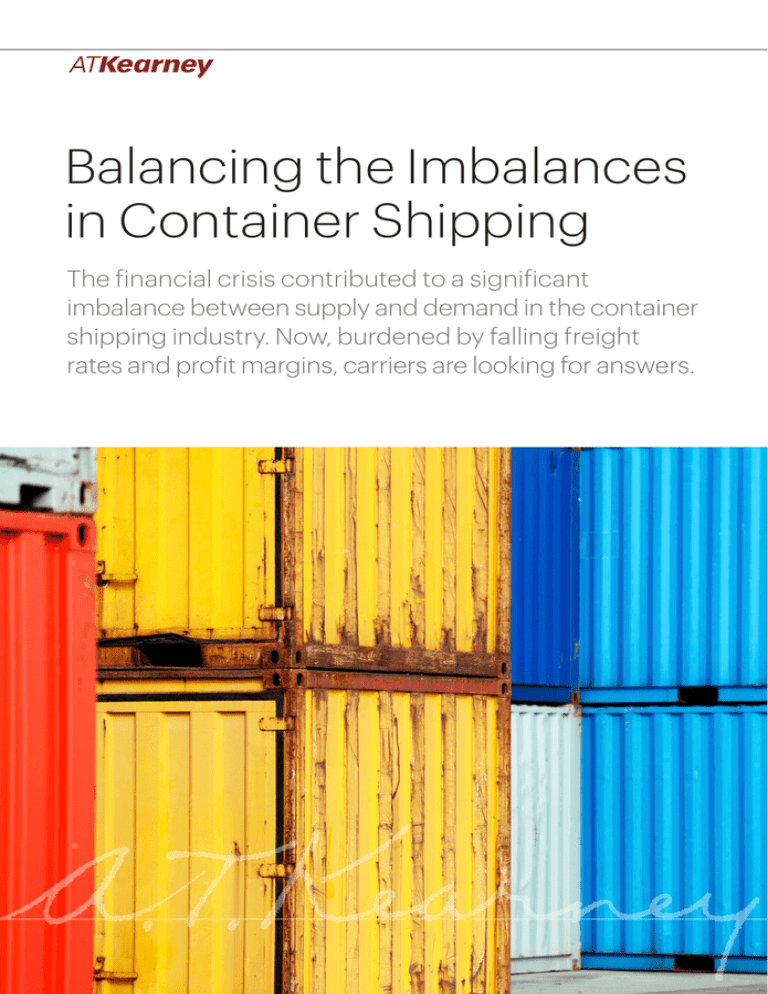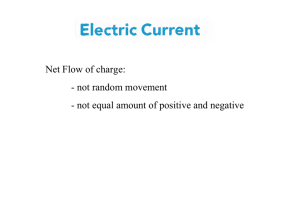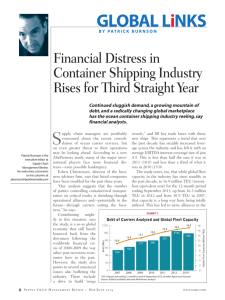
Balancing the Imbalances
in Container Shipping
The financial crisis contributed to a significant
imbalance between supply and demand in the container
shipping industry. Now, burdened by falling freight
rates and profit margins, carriers are looking for answers.
Balancing the Imbalances in Container Shipping
1
The outlook for world trade and container shipping volumes is surprisingly positive. Despite
economic downturns and uncertainty, world trade value is expected to grow by 19 percent from
2011 to 2014, which will result in an almost 90 percent increase since 2005 (see figure 1). Recent
forecasts of container shipping volumes show similarly attractive growth rates taking place in
the next three to five years.
Looking ahead to 2014, the market is expected to be served by a carrier fleet with an approximate capacity of 19.3 million twenty-foot equivalent units (TEU), which is around 24 percent
above today’s fleet size. From 2005 to 2014, the global container vessel fleet will have expanded
disproportionally to trade value growth by as much as 144 percent.
This imbalance between trade and fleet capacity is partially absorbed by a further increase in
the share of containerized freight. Yet overcapacity is, to a large extent, structurally imbedded,
increasing, and likely to last for a long time.
From our work in this industry, we sought to answer several important questions: Is the industry
behaving irrationally? Or are the stronger carriers crowding out weaker carriers by intentionally
flooding the market with additional capacity? Is the growth in capacity due to the increased
marginal return carriers secure with new technology? Are carriers that did not invest rendered
noncompetitive in the long run? No matter which view one takes on the causes, the effects of
the supply-demand imbalance will continue to have a substantial impact on the market and the
industry on a whole.
Figure 1
World trade is expected
expected to
togrow
growalmost
almost90
90percent
percentbetween
between2005
2005and
and2014
2014
Global merchandise trade
(US$ trillions)
+19%
20.000
19.308
18.198
17.152
16.120
15.000
15.237
16.166
+86%
14.003
12.516
12.113
10.399
10.000
5.000
0
2005
2006
2007
2008
2009
2010
2011
2012
2013
2014
Note: Figures for 2011 through 2014 are estimates.
Note: Figures for 2011 through 2014 are estimates.
Sources: World Trade Organization, International Monetary Fund (2010), UNCTAD Review of Maritime Transport, MDS Transmodal; A.T. Kearney analysis
Sources: World Trade Organization, International Monetary Fund (2010), UNCTAD Review of Maritime Transport, MDS Transmodal; A.T. Kearney analysis
Balancing the Imbalances in Container Shipping
2
Three Strategies to Prepare for the Future
It is becoming more important for carriers to have clear strategies and distinct market positions.
While rationalization and cost-cutting measures are appropriate answers to volatile and fiercely
competitive markets, such measures fail to address fundamental structural market challenges,
which are likely to continue in the foreseeable future (see sidebar: Rapid, Dramatic Market
Changes Pose Challenges to Carriers on page 5).
The ability to offer the lowest rates and
still make a profit is crucial for surviving
the rate battle.
Therefore, leading carriers such as Maersk Line, MSC, and CMA CGM appear to follow the
strategy of dominating the market through scale. They may well succeed, as large vessels
provide major economic advantages in lower fuel, capital, and manpower costs per container
carried. However, not all carriers need to follow such strategies to succeed. Large vessels have
to operate between a limited number of ports in order to achieve high utilization and efficient
turnaround. They need to be supported by a dense network of feeder services that require
multiple handlings of containers. Nimble carriers operating smaller vessels may be able to
achieve lower costs on a point-to-point basis than the “market leaders” by calling directly at
ports not served by the mega-ships and thus eliminating extra handling of containers.
The choice of strategy is not based solely on scale; every service provider must have an
innovative market differentiator. In the container shipping industry, a differentiator can be
anything from size, product, lanes, and positioning in the logistics chain (service offerings) to
transportation hardware, client interaction, and pricing. And the strategy of choice should also
reflect the volatility in trade markets.1
To take advantage of the market’s long-term potential, the strongest carriers will have five-year
strategies in place. The following are offered as guidelines:
1. Develop a Strategy for Market Conditions
It might seem irrational to order and deploy new vessels in a market with severe overcapacity,
but there is sound reasoning behind Maersk Line’s decision last year to award Daewoo
Shipbuilding a $3.8 billion contract for 20 Triple-E (18,000 TEU) vessels, which Maersk claims
are the world’s largest and most efficient container vessels. To keep pace, other carriers are
similarly ordering and deploying new, ever-larger vessels. When appropriately utilized, larger
vessels are more cost efficient and better suited to the current market conditions. On average,
slot costs decrease by as much as 50 percent from a 2,500 TEU to a 10,000 TEU vessel—and
the cost advantages of Triple-E vessels are even larger (see figure 2 on page 4).
1See A.T. Kearney Global Business Policy Council study, “The Global Services Location Index”
Balancing the Imbalances in Container Shipping
3
Figure 2
Bigger ships result in
in lower
lowercosts
costsin
inmany
manycategories
categories
Indexed costs
(2,500 TEU = 100)
100
100
16%
90
80
70
Capital cost
13%
Operating cost
70.3
71%
60
12%
50
Bunker cost
17%
54.5
21%
70%
40
30
52.9
19%
13%
11%
66%
70%
6,000 TEU
8,000 TEU
49.8
20%
11%
69%
20
10
0
2,500 TEU
4,000 TEU
10,000 TEU
Ship size
Sources: Drewry reports, interviews
interviews with
with shipping
shippingexecutives
executives
In a very competitive market such as container shipping, the ability to offer the lowest rates
and still make a profit (or worst case, making smaller losses than competitors on key strategic
trades) is crucial for surviving the rate battle. Indeed, offering very low rates over a short period
may be necessary to defend or win market share, secure enough volume to achieve decent
capacity usage, and squeeze out the competition. Deploying more modern and larger vessels is
a powerful cost lever for the following reasons:
• Cost effectiveness. As discussed, larger vessels are more efficient when used at full
capacity. A rule of thumb for older vessels is that a doubling of vessel size results in a 30 to 40
percent decrease in bunker costs per slot. For newer vessels, this factor is around 20 percent.
• Slow steaming. A measure spawned from the financial crisis, slow steaming has a significant
impact on slot costs; it is also a fairly simple way to adjust network capacity in the short term.
The technology of new vessels supports slow steaming better than that of older vessels.
• Smaller crews. Modern vessels require fewer people to operate them, and on a big vessel,
the lower crew costs can be distributed over a larger volume. For example, modern 11,000plus TEU vessels have twice the loading capacity of Panamax vessels but need a crew of only
13 instead of 23.
• Lower capital costs. The new-build cost per slot of larger vessels is less than for smaller
vessels. Therefore, capital costs per slot are lower for larger vessels.
Balancing the Imbalances in Container Shipping
4
Rapid, Dramatic Market Changes Pose Challenges to Carriers
Two years ago, the average cost
of shipping a 40-foot container
from Hong Kong to Hamburg was
$4,830. In August 2011, rates were
less than half that (see figure A).
Although the supply and demand
imbalance has a lot to do with
this drop in shipping costs, it is
only part of the story. Freight
and charter rates are also forced
under water by cutthroat competition for volumes on key trading
routes, and they are negatively
influenced by continued high
uncertainty in the development of
the global economy.
In the commodity-like container
shipping business, price
remains a key differentiator on
which industry leaders intensively compete. Particularly for
Asian-European trade, big players
drive down their slot costs to such
an extent that they squeeze out
smaller players to the smallervolume north-south trades,
thereby triggering a cascade
effect of rate reductions.
Volatile financial markets,
continued turbulence in the Euro
zone, and stagnating growth
in the United States are also
contributing factors. Fearing a
new recession, industry order
volumes that drive import and
export are expected to shrink,
and investments will likely be
postponed. Since July 2010,
shipping executives’ confidence
about their market has consistently been heading downward,
recently hitting a 3½-year low,
according to the Moore Stephens
Shipping Confidence Survey.
Based on the indicative power
of this index, the rate downfall is
not likely to end within the next
month. At the same time, carrier
costs have risen substantially.
Because of increasing oil prices,
bunker prices, which are the main
driver of voyage-related costs,
have increased by 38 percent
since January 2011 alone (see
figure B on page 6). The first
eight months of 2011 brought an
increase from $497 to $687 per
ton of intermediate fuel oil 380.
Undoubtedly, carriers now face
severe challenges with the combination of falling freight rates,
rising costs, uncertain markets,
and more intense consolidation
pressure.
Figure A
Freight
fell
percent
in fell
18 months
Sidebarrates
figure
A:59
Freight
rates
59 percent in 18 months
Freight rates
($ per 40-foot equivalent)
-59%
4,830
5,000
4,500
4,000
Southern China to Northern Europe
Northern Europe to Southern China
Southern China to U.S. West
U.S. West to Southern China
3,500
3,000
2,500
2,000
2,000
1,500
1,000
500
May
2008
Aug
2008
Nov
2008
Feb
2009
May
2009
Aug
2009
Nov
2009
Feb
2010
May
2010
Aug
2010
Nov
2010
Feb
2011
May
2011
Aug
2011
Sources: Drewry reports; A.T. Kearney analysis
Sources: Drewry reports; A.T. Kearney analysis
Balancing the Imbalances in Container Shipping
5
Figure B
Bunker rates
Bunker
rates rose
rose 38
38 percent
percent in
in eight
eightmonths
months
Bunker rates ($ per ton)
+38%
800
$687
700
600
$497
500
400
300
200
May
2008
Aug
2008
Nov
2008
Feb
2009
May
2009
Aug
2009
Nov
2009
Feb
2010
May
2010
Aug
2010
Nov
2010
Feb
2011
May
2011
Aug
2011
Sources: Bunkerworld;
Sources:
Bunkerworld; A.T.
A.T. Kearney
Kearney analysis
analysis
Having a modern fleet will be especially important for the large vessel segment, where significant new and modern capacity is being added. This accelerated development is likely to have
severe consequences for carriers with large but older and less efficient vessels that become
obsolete because they cannot be easily deployed in, for example, regional trades and cannot
compete on long hauls.
Fleet composition is not only about deploying the best-suited vessels but also about having
the optimal mix of owned and time-chartered (T/C) vessels. The advantages of time-chartered
vessels are flexibility and the fact that carriers can sometimes secure some very attractive deals.
For example, when the only other alternative for a vessel owner is to lay up the vessel to wait for
better times, very low T/C rates can be a more attractive option.
However, there is also significant shipyard overcapacity, and new building prices are very low.
So, for financially solid carriers that have easy access to capital, buying new modern vessels
at almost bargain prices might represent a more attractive opportunity than entering into T/C
agreements for older vessels. The flexibility to choose between owning and chartering gives
these carriers a clear competitive advantage under current market conditions.
2. Design the Best Network
The attractiveness of different trade routes varies. The very competitive Asia to Europe head-haul
lane offers high volumes, but the backhaul direction has much lower vessel utilization, typically
around 50 to 70 percent.2 Obviously, achieving the lowest possible slot costs is vital to remain
competitive in this major long-haul trade. In contrast, the tonnage-wise smaller north-south
routes experience less intense competition and are, on average, served by smaller vessels.
2In contrast to previous years, utilization was well above 80 percent on backhaul routes at the beginning of 2011 as demand for imports in Asia
increased, but margins remained negative for service providers. The increased demand may offset lower revenues on the head-haul side.
Balancing the Imbalances in Container Shipping
6
While global carriers have to offer their own or shared services on all major trade lanes, smaller
players and those that mainly focus on certain areas, such as feeder business, should consider
their choices wisely. The message to carriers is simple but effective: Optimize your network
to increase revenues, reduce operating costs, and maximize returns. Although this sounds
obvious, network design often lacks analytical rigor, and as a consequence, the resulting
commercial decisions risk being flawed. In addition, it often takes a long time to realize that
a specific service is not profitable and to correct a wrong decision. Naturally, routes are not
intentionally served unprofitably, but it can have a negative impact on the market and thus
affect all participants.
The most successful carriers will be those
that are efficient, flexible, and the easiest
for customers to do business with.
Strategic and tactical network optimization requires access to accurate key data across several
functions, and it requires transparent, well-designed information technology systems to deliver
this data. Areas that should be considered as part of a network optimization are as follows:
• Characteristics and outlook for trades served. Evaluate all aspects, including profitability,
competition, and rate development
• Degree of flexibility within the network. Gauge all matters of flexibility. For example, slow
steaming might provide flexibility to adjust capacity, but it also requires a high degree of
network flexibility
• Potential to optimize port stays. Consider various factors, including port performance and
the frequency with which port stays are serviced
• Quality of vessel stowage. Look for potential improvement opportunities
• Pricing optimization. Examine ways to cut costs or improve yield management
• Balance head- and backhaul cargo flow. Plug performance gaps
Optimizing a carrier’s fleet composition and designing the best possible network are closely
related decisions that should not be considered in isolation.
3. Grow the Business
The size of a carrier matters. First, large carriers are less vulnerable to regional downturns because
they can more easily adjust their network and capacity incrementally. Second, they have an easier
time financing strategic investments (although this is not universally true). Third, and most
important, large carriers with global networks can offer their customers global services and more
choices to route their volumes in the most efficient ways. Overall, large carriers manage to secure
more constant cargo volumes and therefore achieve higher use of their assets. At the same time,
for carriers with a well-balanced portfolio based on serving multiple markets with global networks,
the impact of poor returns on particular routes is softened when other markets do well.
Balancing the Imbalances in Container Shipping
7
There are three ways for carriers to grow their businesses:
Organic. Most carriers attempt organic growth. In 2010, the top 10 carriers increased their
capacity by 14 percent versus 8 percent for the overall market. This growth is not solely based
on newly constructed fleets. Alphaliner, an independent agency that provides market data for
the liner shipping industry, reports that, on average, half—51.5 percent—of the existing fleet is
chartered from non-operating owners.
Although current conditions suggest a market ripe for consolidation, some stronger carriers
believe the time is right to simply use the low rates and their slot cost advantage to squeeze out
weaker competitors for good. The idea is not to lay up capacity to sustain declining rates, as
they did a few years ago, but instead to let rates decline to a level where carriers with higher slot
costs simply go out of business. In doing so, the better-positioned carriers force an adjustment
of global capacity and at the same time gain market share. Maersk Line, MSC, and CMA CGM are
using this approach to drive out smaller competitors on the Asia-Europe trade.
Acquisitions. Although the overall industry remains fragmented with the top five players
holding 45 percent market share (up from 35 percent market share in 2004), there are patterns
of consolidation and growth strategies based on acquisition (see figure 3). Mergers and acquisitions (M&A) activity in container shipping has occurred in spikes, such as when Maersk Line
bought Safmarine and Sea-Land in 1999 and acquired P&O Nedlloyd in 2005, and when CMA
CGM bought Delmas in 2006. Historically, however, acquisitions in this industry have not been
without challenges and have not been as successful as expected. Whether it is acquisitions or a
shakeout that drives consolidation, the trend is likely to continue for a number of reasons:
Figure 3
The industry continues to consolidate
Market concentration
(% of market share)
100%
89.3%
88.1%
90%
75.0%
73.7%
80%
84.4%
82.1%
70%
70.1%
64.5%
60%
44.8%
43.4%
50%
40%
41.5%
35.3%
30%
Jan 2004
Jan 2010
20%
Dec 2010
Aug 2011
10%
0%
Top 1
Top 5
Top 10
Top 15
Top 20
Top 25
Top 30
Sources: Alphaliner; A.T. Kearney analysis
Sources: Alphaliner; A.T. Kearney analysis
Balancing the Imbalances in Container Shipping
8
• Poor financial returns. Persistent industry overcapacity during a period of weak global
economic growth has weakened a number of large operators.
• Megaships. The move to container ships of more than 12,000 TEU favors large operators able
to exploit economies of scale.
• The “portfolio effect.” For large carriers serving multiple markets with global networks, the
impact of poor returns on particular routes is softened when other markets do well.
Strategic alliances. Strategic alliances are an option for carriers that cannot or do not want
to engage in M&A activities or do not have a competitive cost base. Several carriers join forces
to gain scale advantage—but at the cost of giving up some control and flexibility. In terms of
control, vessel-sharing agreements are more attractive than slot charter agreements (SCAs)
because carriers will remain active on a string, while with SCAs, carriers often give up their own
vessels. There are also other alliance options for concentrating volume, efficiently utilizing vessel
capacity, and offering more competitive prices or secure financing for new assets. Analysis
shows that the average vessel size employed within global alliances such as the CHKY Alliance
or Grand Alliance are at least double the size of the vessels used by individual members. While
alliances are currently mostly formed on global trade routes, applying this principle to regions,
such as on intra-Asian or Baltic trades, may also be a way forward for feeder operators.
Navigating the Route Forward
Size alone does not automatically guarantee success. What matters is a mixture of strategic
elements. And perhaps it is not wise to copy the leaders’ strategies but rather to find a different
approach that can build and exploit market conditions. Strategies to prepare for the future—
including fleet composition, network design, and leveraged scale—are equally important; using
them fully and balancing them wisely is critical for carriers to navigate the challenging waters
ahead. Developing appropriate tactics in all three areas requires high-quality, comprehensive
information to see through the current fog.
As with most industries, attracting customers is a main objective. The most successful carriers
will be those that are efficient, flexible, and the easiest for customers to do business with. The
intermediaries, including global freight forwarders and non-vessel operating common carriers,
have steadily increased their market share and are now focused on automating their customerfacing and internal processes. There is no better time than now for carriers of all sizes to
consider initiatives and investments for improving transparency and customer processes.
Authors
Jens Søndergaard, partner, Copenhagen
jens.sondergaard@atkearney.com
Lars R. Eismark, partner, Copenhagen
lars.r.eismark@atkearney.com
Jan Bovermann, principal, Frankfurt
jan.bovermann@atkearney.com
Balancing the Imbalances in Container Shipping
9
A.T. Kearney is a global team of forward-thinking, collaborative partners that delivers
immediate, meaningful results and long-term transformative advantage to clients.
Since 1926, we have been trusted advisors on CEO-agenda issues to the world’s
leading organizations across all major industries and sectors. A.T. Kearney’s offices
are located in major business centers in 39 countries.
Americas
Atlanta
Calgary
Chicago
Dallas
Detroit
Houston
Mexico City
New York
San Francisco
São Paulo
Toronto
Washington, D.C.
Europe
Amsterdam
Berlin
Brussels
Bucharest
Budapest
Copenhagen
Düsseldorf
Frankfurt
Helsinki
Istanbul
Kiev
Lisbon
Ljubljana
London
Madrid
Milan
Moscow
Munich
Oslo
Paris
Prague
Rome
Stockholm
Stuttgart
Vienna
Warsaw
Zurich
Asia Pacific
Bangkok
Beijing
Hong Kong
Jakarta
Kuala Lumpur
Melbourne
Mumbai
New Delhi
Seoul
Shanghai
Singapore
Sydney
Tokyo
Middle East
and Africa
Abu Dhabi
Dubai
Johannesburg
Manama
Riyadh
For more information, permission to reprint or translate this work, and all other correspondence,
please email: insight@atkearney.com.
A.T. Kearney Korea LLC is a separate and
independent legal entity operating under
the A.T. Kearney name in Korea.
© 2012, A.T. Kearney, Inc. All rights reserved.
The signature of our namesake and founder, Andrew Thomas Kearney, on the cover of this
document represents our pledge to live the values he instilled in our firm and uphold his
commitment to ensuring “essential rightness” in all that we do.





